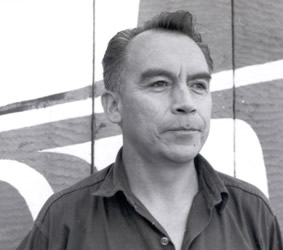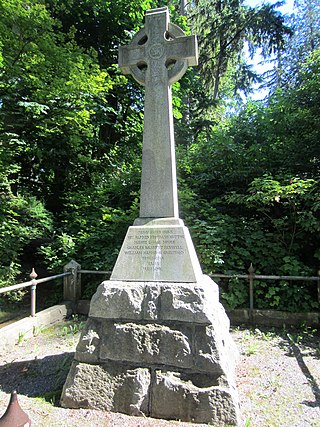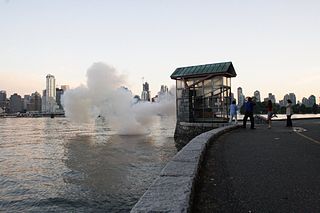
Totem poles are monumental carvings found in western Canada and the northwestern United States. They are a type of Northwest Coast art, consisting of poles, posts or pillars, carved with symbols or figures. They are usually made from large trees, mostly western red cedar, by First Nations and Indigenous peoples of the Pacific Northwest Coast including northern Northwest Coast Haida, Tlingit, and Tsimshian communities in Southeast Alaska and British Columbia, Kwakwaka'wakw and Nuu-chah-nulth communities in southern British Columbia, and the Coast Salish communities in Washington and British Columbia.

Stanley Park is a 405-hectare (1,001-acre) public park in British Columbia, Canada that makes up the northwestern half of Vancouver's Downtown Peninsula, surrounded by waters of Burrard Inlet and English Bay. The park borders the neighbourhoods of West End and Coal Harbour to its southeast, and is connected to the North Shore via the Lions Gate Bridge. The historic lighthouse on Brockton Point marks the park's easternmost point. While it is not the largest of its kind, Stanley Park is about one-fifth larger than New York City's 340-hectare (840-acre) Central Park and almost half the size of London's 960-hectare (2,360-acre) Richmond Park.

John Deighton, better known as "Gassy Jack", was a bar-owner in British Columbia. The Gastown neighbourhood of Vancouver, British Columbia takes its name from him.

Manuka Oval is a sporting venue in Canberra, the capital of Australia. It is located in Griffith, in the area of that suburb known as Manuka. Manuka Oval has a seating capacity of 13,550 people and an overall capacity of 16,000 people, although this is lower for some sports depending on the configuration used. The area on which the ground is situated has been used for sport since the early 20th century, but was only enclosed in 1929. It has since undergone several redevelopments, most recently beginning in 2011.

The Prime Minister's XI or PM's XI is an invitational cricket team picked by the Prime Minister of Australia for an annual match held at the Manuka Oval in Canberra against an overseas touring team. The Australian team usually consists of up and coming grade cricketers from the Canberra region and state players.

The history of Vancouver, British Columbia, is one that extends back thousands of years, with its first inhabitants arriving in the area following the Last Glacial Period. With its location on the western coast of Canada near the mouth of the Fraser River and on the waterways of the Strait of Georgia, Howe Sound, Burrard Inlet, and their tributaries, Vancouver has – for thousands of years – been a place of meeting, trade, and settlement.

Henry Hunt was a First Nations woodcarver and artist from the Kwakwaka'wakw people of coastal British Columbia. He carved a number of totem poles which are on public display in Canada and internationally.
August Jack was an Indigenous/Aboriginal chief of the Squamish people. He was born in the village of Xwayxway or Chaythoos on the peninsula that is now Stanley Park, Vancouver, British Columbia, Canada, the son of Supple Jack "Khay- Tulk" of Chaythoos and Sally "Owhaywat" from the Yekwaupsum Reserve north of Squamish, British Columbia. His grandfather was Chief Khahtsahlano of Senakw who had migrated from his home at Toktakanmic on the Squamish River to Chaythoos, and the man from whom he inherited his name. The suffix "lan-ogh" in their name means "man".

Captain Edward Stamp was an English mariner and entrepreneur who contributed to the early economic development of British Columbia and Vancouver Island. Born at Alnwick in Northumberland, Stamp served as the captain of a steam transport in the Crimean War in 1854.
This is a timeline of the history of Vancouver.

Ellen Neel (1916–1966) was a Kwakwakaʼwakw artist woodcarver and is the first woman known to have professionally carved totem poles. She came from Alert Bay, British Columbia, and her work is in public collections throughout the world.
Larwill Park, also known as the Cambie Street Grounds, is a former park and sporting field in what is now downtown Vancouver, British Columbia, Canada. Larwill Park was the location of the bus depot of Pacific Coach Stage Lines and Greyhound Bus Lines from World War II until 1993, when the bus depot moved to Pacific Central Station. Since then, Larwill Park has been a parking lot. The Vancouver Art Gallery has selected it for the location of a new museum building.

The architecture of Vancouver and the Greater Vancouver area consists of a variety of modern architectural styles, such as the 20th-century Edwardian style and the 21st-century modernist style. Initially, the city architects embraced styles and ideas developed in Europe and the United States, with only limited local variation.
Brockton Oval is a playing area near the Brockton Point located on the north side of Coal Harbour in Vancouver, British Columbia, Canada. The ground was established 1891 with 10 sport's groups joining together. In 1927, cricket and rugby fields were carved out.

Brockton Point Lighthouse is located in Stanley Park, Vancouver, British Columbia. The light was first established at the location in 1890. A square tower, painted white with a red horizontal stripe, was built in 1914. The lighthouse was designed by William P. Anderson and has a red lantern and an arched base with a walkway underneath. The light has been officially inactive since 2008 but may still be displayed occasionally for decorative purposes.

The Chehalis Cross, or Chehalis Monument, is a Celtic cross memorial commemorating the eight people who died when the tugboat Chehalis sank off Stanley Park. The monument is installed west of Brockton Point in Vancouver, British Columbia.

Stanley Clifford Hunt is a Canadian, First Nations Kwakiutl artist from British Columbia.
Tim Paul is a member of the Hesquiaht tribe from the Nuu-Chah-Nulth first nation. He is a master carver from Esperanza Inlet British Columbia. He was the senior carver at the Royal British Columbia Museum until 1992 when he left to oversee an indigenous education program for the Port Alberni school board on Vancouver Island.















